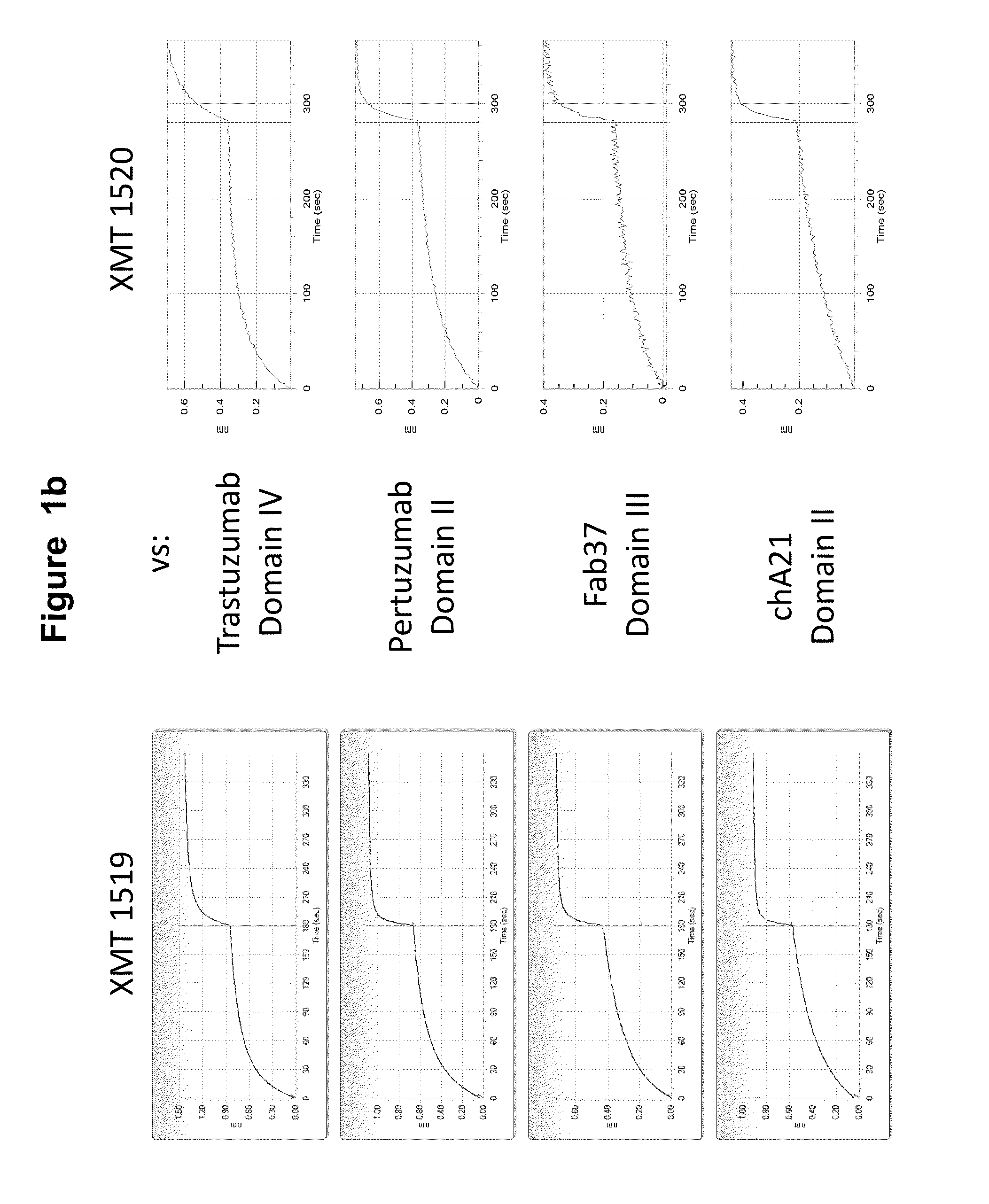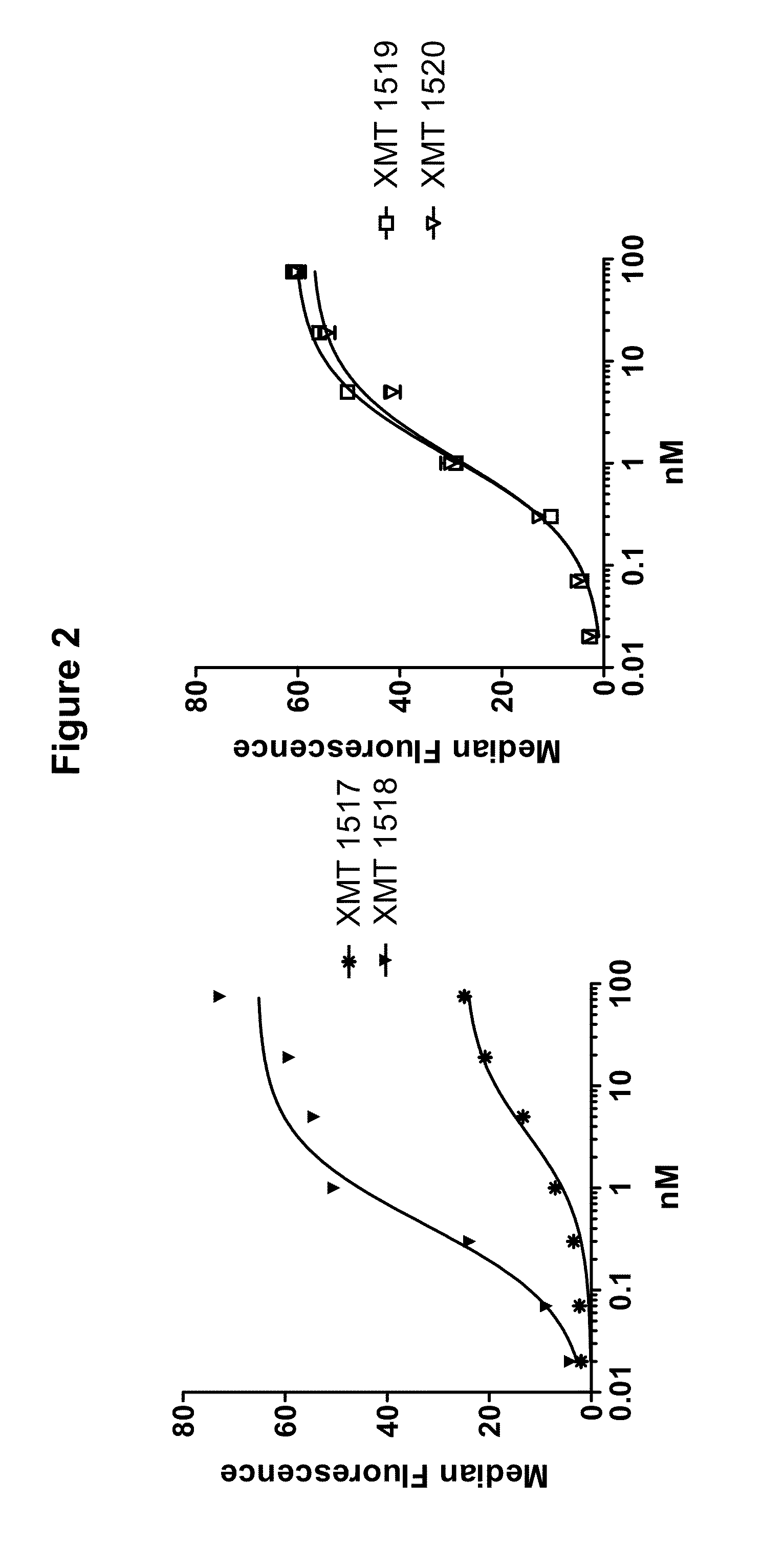Monoclonal antibodies against her2 epitope and methods of use thereof
- Summary
- Abstract
- Description
- Claims
- Application Information
AI Technical Summary
Benefits of technology
Problems solved by technology
Method used
Image
Examples
example 1
FACS Selection for HER2 Antibodies
[0576]Two of the HER2 antibodies disclosed herein, XMT 1517 and XMT 1519, were selected using the procedure described below. Eight naïve human synthetic yeast libraries each of ˜109 diversity were propagated as described previously (see, for example, WO 2009036379; WO2010105256; WO2012 / 009568; and Xu et al., Protein Eng Des Sel. 2013 October; 26(10):663-70). For the first two rounds of selection, a magnetic bead sorting technique utilizing the Miltenyi MACs system was performed, as described (Siegel et al., J Immunol Methods. 2004 March; 286(1-2):141-53). Briefly, yeast cells (˜1019 cells / library) were incubated with 3 ml of 200 nM biotinylated monomeric HER2 antigen or 10 nM biotinylated HER2-Fc fusion antigen for 15 min at room temperature in FACS wash buffer PBS with 0.1% BSA (biotinylations were done using the EZ-Link Sulfo-NHS-Biotinylation Kit, Thermo Scientific, Cat.#21425). After washing once with 50 ml ice-cold wash buffer, the cell pellet ...
example 2
Affinity Maturation of HER2 Antibodies
[0577]The affinity matured HER2 antibodies disclosed herein, XMT 1518 and XMT 1520, were made using the procedure described below. A Round 5 binding population was used for a light chain batch diversification (LCBD). Heavy chain plasmids were extracted and transformed into a light chain library with a diversity of 1×106. Selections were performed as described above with one round of MACS sorting and two rounds of FACS sorting using 10 nM or 1 nM biotinylated antigen for respective rounds.
[0578]Further affinity maturation was performed on the best clones from the LCBD. Each of the CDRH3 of the heavy chains from these clones were individually recombined into a premade library with variants of a diversity of 1×108 and selections were performed as described above. Affinity pressures were applied by incubating the antigen antibody yeast complex with parental Fab for different amounts of time to select for the highest affinity antibodies.
[0579]A third...
example 3
Antibody Production and Purification
[0580]Yeast clones were grown to saturation and then induced for 48 h at 30° C. with shaking After induction, yeast cells were pelleted and the supernatants were harvested for purification. IgGs were purified using a Protein A column and eluted with acetic acid, pH 2.0. Fab fragments were generated by papain digestion and purified over KappaSelect (GE Healthcare LifeSciences, Cat.#17-5458-01).
[0581]Mammalian expression of IgG was done by sub-cloning antibodies into new expression vector follow by transient transfection and expression in HEK. Briefly, expression vectors containing the antibody of interest are transfected by complexing with a transfection reagent followed by exposure to HEK cells for one hour followed by dilution of culture media to a final density of 4 million cells per mL. The cells are then cultured for 7 days with fresh feed media every 48 hours. After 7 days, the supernatant is collected following centrifugation and purificatio...
PUM
| Property | Measurement | Unit |
|---|---|---|
| Atomic weight | aaaaa | aaaaa |
| Atomic weight | aaaaa | aaaaa |
| Atomic weight | aaaaa | aaaaa |
Abstract
Description
Claims
Application Information
 Login to View More
Login to View More - R&D
- Intellectual Property
- Life Sciences
- Materials
- Tech Scout
- Unparalleled Data Quality
- Higher Quality Content
- 60% Fewer Hallucinations
Browse by: Latest US Patents, China's latest patents, Technical Efficacy Thesaurus, Application Domain, Technology Topic, Popular Technical Reports.
© 2025 PatSnap. All rights reserved.Legal|Privacy policy|Modern Slavery Act Transparency Statement|Sitemap|About US| Contact US: help@patsnap.com



